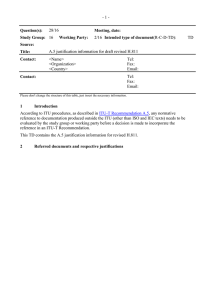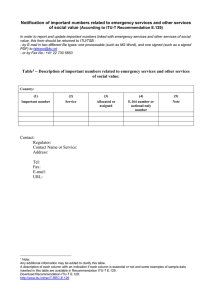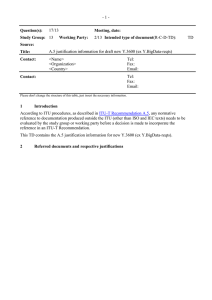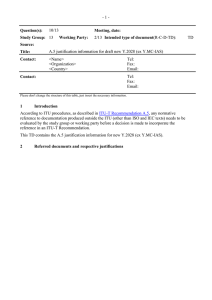I T U NTERNATIONAL
advertisement
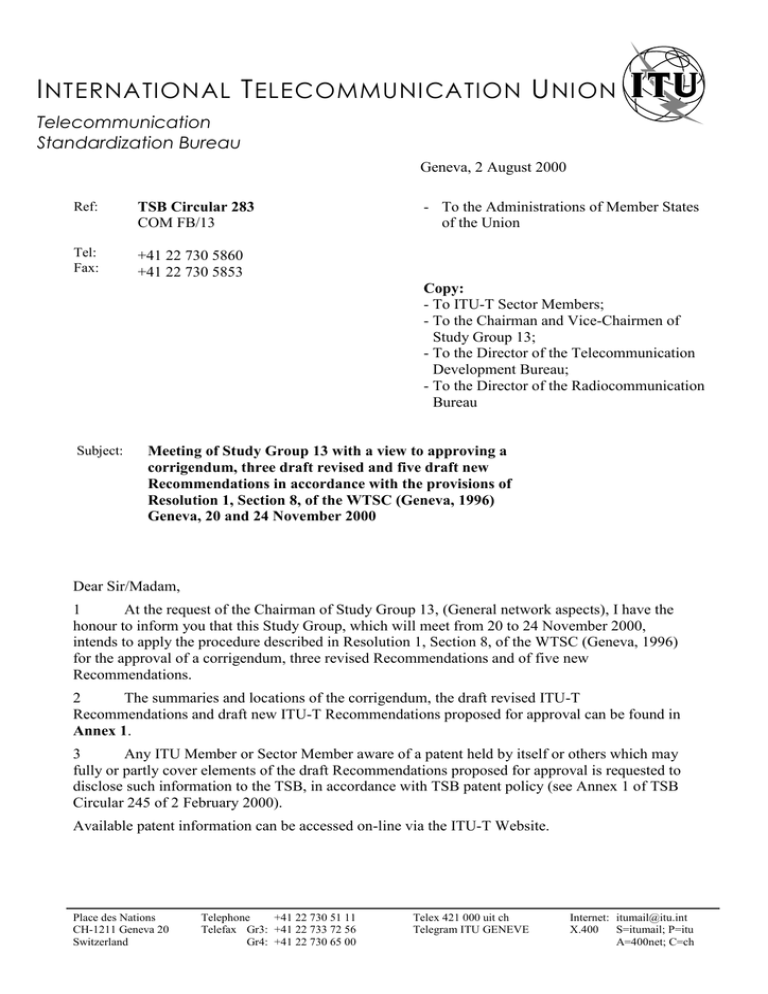
I NTERNATIONAL T ELECOMMUNICATION U NION Telecommunication Standardization Bureau Geneva, 2 August 2000 Ref: TSB Circular 283 COM FB/13 Tel: Fax: +41 22 730 5860 +41 22 730 5853 - To the Administrations of Member States of the Union Copy: - To ITU-T Sector Members; - To the Chairman and Vice-Chairmen of Study Group 13; - To the Director of the Telecommunication Development Bureau; - To the Director of the Radiocommunication Bureau Subject: Meeting of Study Group 13 with a view to approving a corrigendum, three draft revised and five draft new Recommendations in accordance with the provisions of Resolution 1, Section 8, of the WTSC (Geneva, 1996) Geneva, 20 and 24 November 2000 Dear Sir/Madam, 1 At the request of the Chairman of Study Group 13, (General network aspects), I have the honour to inform you that this Study Group, which will meet from 20 to 24 November 2000, intends to apply the procedure described in Resolution 1, Section 8, of the WTSC (Geneva, 1996) for the approval of a corrigendum, three revised Recommendations and of five new Recommendations. 2 The summaries and locations of the corrigendum, the draft revised ITU-T Recommendations and draft new ITU-T Recommendations proposed for approval can be found in Annex 1. 3 Any ITU Member or Sector Member aware of a patent held by itself or others which may fully or partly cover elements of the draft Recommendations proposed for approval is requested to disclose such information to the TSB, in accordance with TSB patent policy (see Annex 1 of TSB Circular 245 of 2 February 2000). Available patent information can be accessed on-line via the ITU-T Website. Place des Nations CH-1211 Geneva 20 Switzerland Telephone +41 22 730 51 11 Telefax Gr3: +41 22 733 72 56 Gr4: +41 22 730 65 00 Telex 421 000 uit ch Telegram ITU GENEVE Internet: itumail@itu.int X.400 S=itumail; P=itu A=400net; C=ch -2- 4 Having regard to the provisions of Resolution 1, Section 8, I should be grateful if you would inform me by 2400 hours UTC on 8 November 2000 whether your Administration assigns authority to Study Group 13 that these draft revised or new Recommendations should be considered for approval at the Study Group meeting. Should any Member States be of the opinion that consideration for approval should not proceed, they should advise their reasons for disapproving and indicate the possible changes that would facilitate further consideration and approval of the draft revised or new Recommendations. 5 If 70% or more of the replies from Member States support consideration for approval of these draft revised or new Recommendations at the Study Group meeting, one Plenary session will be devoted on 20 November 2000 to apply the approval procedure. In cases where contributions have been received proposing changes to the text of draft revised, new and amended Recommendations (other than those of an editorial nature presented by the Rapporteur/editor) their approval will take place at the closing Plenary on 24 November 2000. I accordingly invite your Administration to send a representative to the meeting. The Administrations of Member States of the Union are invited to supply the name of the Head of their delegation. If your Administration wishes to be represented at the meeting by a recognized operating agency, a scientific or industrial organization or another entity dealing with telecommunication matters, the Director should be duly informed, in accordance with Article 19, No. 239, of the Convention of the International Telecommunication Union (Geneva, 1992), as amended by the Plenipotentiary Conference (Minneapolis, 1998). 6 The agenda, registration form and all relevant information concerning the Study Group 13 meeting will be available from Collective-letter 14/13. 7 Information on the meeting room will be displayed on the screens at the entrances to the ITU headquarters building. 8 After the meeting, the Director of TSB will notify, in a circular, the decision taken on these Recommendations. This information will also be published in the ITU Notification. Yours faithfully, H. Zhao Director of the Telecommunication Standardization Bureau Annex: 1 -3- ANNEX 1 (to TSB Circular 283) Summaries and locations of the ITU-T Recommendations for approval at the meeting of Study Group 13 (Geneva, 20-24 November 2000) 1. Draft new ITU-T Recommendation Y.140 (ex Y.POIF) - Global Information Infrastructure (GII) - Reference points for interconnection framework (published in COM 13-R 70) This Recommendation sets the scene for interconnection within the framework of the GII, a multioperator, multi-provider and multi-vendor telecommunications environment. The significance of interconnection in particular scenarios is dealt with in separate Annexes. These include PSTN/ISDN, PSTN/ISDN access network, gateway architectures, service provider access and management systems/TMN. The Annexes, the Appendix and the bibliography list interconnection related Recommendations and also standards developed by other organizations cooperating with ITU. 2. Draft new ITU-T Recommendation Y.1001 (ex Y.IPF) - IP Framework A framework for convergence of telecommunications network and IP network technologies (published in COM 13-R 70) In order to support the development of IP-related standards, this Recommendation identifies a framework to position the telecommunications aspects with respect to IP networks. This framework serves to identify and assist understanding the IP network issues, from the telecommunications point of view, with respect to the provision of seamless services to the user between IP networks and telecommunications networks in a convergence context. This Recommendation outlines a number of general architectures involving a mix of Telecommunication Network and Internet Protocol (IP) Network technologies. In this document IP, the Internet Protocol, is considered in its role as a protocol purely associated with transporting connectionless packets. 3. Corrigendum to ITU-T Recommendation Y.120 (published in COM 13-R 70) Replace existing Figure 5/Y.120 4. Draft revised ITU-T Recommendation I.366.2 -AAL type 2 service specific convergence sublayer for narrow-band services (published in COM 13-R 73) This Recommendation defines a Service Specific Convergence Sublayer that operates above the Common Part Sublayer of an AAL type 2 connection. The purpose of the SSCS is to convey narrow-band channels consisting of voice, voiceband data, or circuit mode data. The SSCS specifies packet formats and procedures to encode the different information streams for bandwidth-efficient transport by AAL type 2. It accommodates known techniques of low rate audio encoding, silence compression, and facsimile demodulation/remodulation. It makes provision for in-band signalling of narrow-band calls and for control of the SSCS operating state. -4- The SSCS anticipates that multiplexing in the Common Part Sublayer will be used to carry multiple narrow-band channels over individual ATM connections. Additional details needed to configure and manage trunk groups or access configurations, however, are beyond the scope of this Recommendation. The focus is on normative aspects of SSCS coding and behaviour within a single AAL type 2 connection. 5. Draft new ITU-T Recommendation I.371gfr - Guaranteed frame rate ATM transfer capability – (published in COM 13-R 73) This Recommendation specifies the Guaranteed Frame Rate ATM Transfer Capability as an extension to the ATCs specified in ITU-T Recommendation I.371. 6. Draft revised ITU-T Recommendation I.363.2 - B-ISDN ATM adaptation layer (AAL) type 2 specification (published in COM 13-R 73) This Recommendation specifies the AAL type 2 that provides for the bandwidth-efficient transmission of low-rate, short, and variable length packets in delay sensitive applications. More than one AAL type 2 user information stream can be supported on a single ATM connection. This Recommendation covers the specification of the frame structure of the short and variable length packets, the packing of short length packets into one (or more) ATM cells, and the mechanisms to recover from transmission errors. This Recommendation describes the interactions between AAL type 2 and the next higher layer, between AAL type 2 and the ATM layer, and between AAL type 2 and Layer Management, as well as AAL type 2 peer-to-peer operations. 7. Draft New ITU-T Recommendation Y.1231 - IP Access Network Architecture (published in COM 13-R 76) This Recommendation provides the definitions of terminology regarding IP access, and the high-level IP network architecture and models for the IP services. It describes the access types and interfaces to be supported by the IP access network, the IP access network capabilities and requirements, and the IP access network functional models and possible arrangements. 8. Draft new Recommendation G.827.1 - Availability performance objectives for end-toend international constant bit-rate digital paths at or above the primary rate (published in COM 13-R 78) Recommendation G.827.1 defines network performance objectives for describing end-to-end availability performance of international constant bit rate digital paths at or above the primary rate. The parameters to which these objectives apply are defined in G.827. The objectives given are independent of the physical network supporting the path. Guidance on determining expected end-to-end performance using the objectives for path elements is provided in an annex, and depends on the actual path topology. -5- 9. Draft revised Recommendation I.357 - B-ISDN semi-permanent connection availability (published in COM 13-R 78) This Recommendation defines network performance parameters, objectives and measurement methods for describing B-ISDN ATM semi-permanent connection availability. The specified parameters and objectives apply to international ATM semi-permanent connection portions delimited by measurement points: National Portions, International Transit Portions and International Interoperator Portions. The objectives, which are worst-case values, are intended to assist providers in network planning by limiting the aggregate effect of network impairments, including congestion, equipment failures and transmission errors. Guidance on determining expected end-to-end performance is provided in Annex C. A two-state availability model is defined along with criteria for entry into and exit from the unavailable state. An estimation procedure is also defined, providing a means of estimating availability performance using sampling techniques.
